Robust solutions for sediment and water quality improvement
The Precision Erosion and Sediment Management Research Group (PrESM) develops timely, cost-effective strategies to precisely define and manage erosion and sediment sources in our waterways and catchments.
We work to reduce sediment yields from sources within catchments to improve the water quality of downstream ecosystems, especially the Great Barrier Reef.
PrESM apply academic rigour and field-based innovation to a broad suite of precision landscape analysis methods and emerging techniques.
Our research has contributed key insights into the identification and targeting of sediment sources, prompting significant shifts in government policy and practice.
Our Impact
The Eureka moment that could help save the reef
In 2004, Associate Professor Andrew Brooks took a flight that would change the entire focus of his research on rivers. More than a decade on, the Griffith University scientist has become a game-changer in the battle to save what remains of the magnificent Great Barrier Reef.
Primary researchers
Lab Head
Geomorphology, catchment management, water quality, river management
John Spencer
Senior Research Assistant
Geomorphology, GIS, instrumentation, field logistics
Senior Research Fellow
Optical dating, quaternary geochronology
Associate Professor
Environmental geochemistry
Research Fellow
Geomorphology, gully erosion, landscape evolution
Dr Robin Thwaites
Senior Research Fellow
Geomorphology, gully erosion, soil sciences
Dr Justin Stout
Adjunct Research Fellow
Geomorphology, LiDAR analysis, hydraulic modelling, statistical modelling
Adjunct Senior Research Assistant
GIS
Senior Research Fellow
Gully erosion, water quality, sediment dynamics, optical dating, geochemistry
Emeritus Professor
Fluvial geomorphology, sediment tracing, geochemistry, optical dating
Adjunct Research Fellow
Biogeochemistry, wetlands, catchment nutrient processes
Our expertise
We provide scientific knowledge and problem-solving expertise to the major erosion, sediment load and rehabilitation challenges of sustainable land management.
Our core members provide expertise and experience in:
- Fluvial geomorphology
- Gully geomorphology
- Catchment management prioritisation
- River rehabilitation and gully remediation
- Soil/fluvial erosion and sediment transport dynamics
- Soil science and soil geomorphology
- Field instrumentation
- Geochemistry
- Sediment tracing
- Optical dating
- Spatial analysis & remote sensing
- Hydraulic modelling
- Water quality monitoring
- Reef credits
Research projects
Optimal approaches for alluvial gully treatment
Having identified in previous research that gully erosion represents one of the primary threats to water quality in the Great Barrier Reef lagoon, this project aims to trial and evaluate the most effective methods for rehabilitating large alluvial gullies. The aims of the project were to determine:
- What percentage of sediment reductions can be achieved by undertaking large-scale alluvial gully rehabilitation using optimal approaches?
- How does this vary for different gullies depending on gully and soil material type?
- What are the associated nutrient reductions?
- What are the most cost-effective monitoring approaches?
Funding source: NESP Project 3.1.7
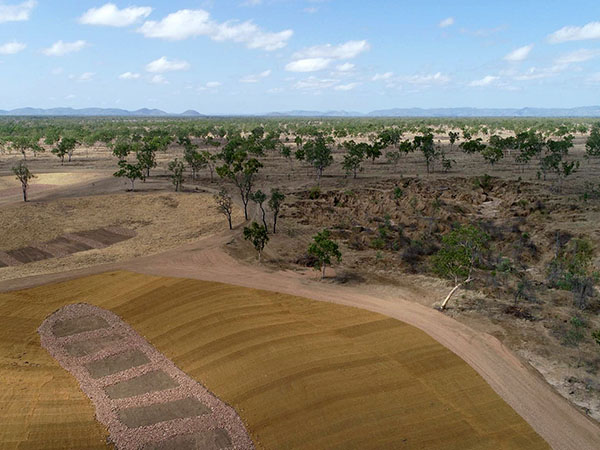
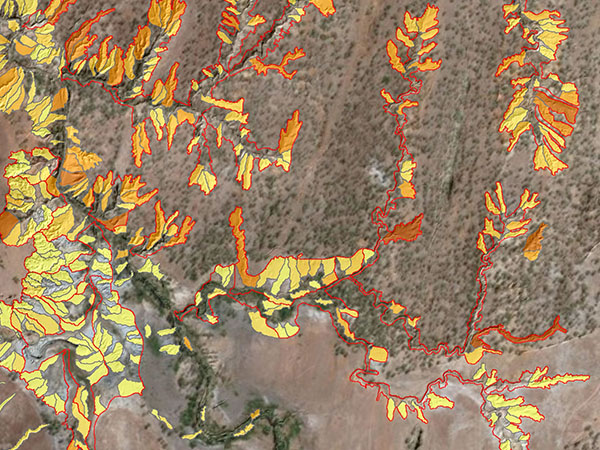
Automated gully mapping from LiDAR in the Great Barrier Reef
Accurately mapping gullies at high resolution and quantifying their key attributes is the critical first step in the process of prioritising and designing rehabilitation solutions. At least 40% of the accelerated erosion contributing to poor water quality in the Great Barrier Reef (GBR) lagoon is sourced from gully erosion, demanding effective management and rehabilitation of these features. Current gully maps across the GBR are low resolution and overly simple, providing no differentiation between gully type. Airborne LiDAR is now widely recognised as the best way to accurately map gullies at landscape scale and suitable resolution for management planning. Given the large volume of LiDAR data becoming available, tools developed in this project enable the location of gullies to be extracted from LiDAR digital elevation models (DEM), along with key attributes of the gullies, enabling them to be grouped into classes of similar gully types to aid prioritisation, management and catchment modelling.
Funding source: NESP Project 5.10
Landholders driving change – gully prioritisation
The Bowen, Broken and Bogie (BBB) major integrated project is an initiative of the Queensland Government’s Reef Task Force, intended to focus resources in the most significant erosion hotspot within the Great Barrier Reef’s catchments—the BBB catchment. The project maps and classifies gullies throughout the BBB catchment at high resolution from LiDAR data and determine which are the highest priority for cost-effective management. To do this we developed semi-automated processes for extracting gullies from LiDAR data, with gully types analysed to determine their relative sediment yields. This data formed the basis for an economic analysis to determine which gullies are the most cost-effective to rehabilitate, delivering the maximum sediment reduction to the reef in the shortest time. Detailed analysis, including on-ground assessment and soil sampling, is then undertaken at the highest priority gullies and baseline erosion rates established.
Funding sources: NQ Dry Tropics/Queensland Government Landholders Driving Change Project
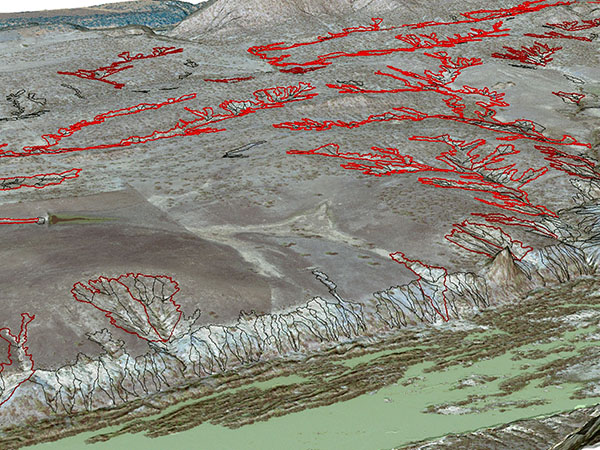
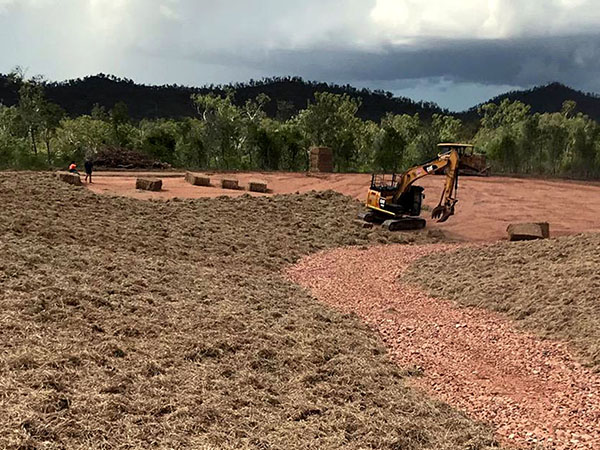
Development of reef credits assessment method for gully erosion
An innovative new market-based approach to dealing with water quality improvement has been initiated with the recent launch of the Reef Credit scheme. Modelled on Carbon Credits, Reef Credits enable investors (such as government, corporates, philanthropists or individuals) to purchase a measurable water quality improvement. This is a major shift from the current process where government (primarily) funds the inputs to water quality projects with the hope that they will eventually deliver a water quality improvement. Under the Reef Credits approach, water quality improvements must be delivered and verified before a credit is paid, significantly improving the confidence that investors will achieve the outcome they seek. Given that we know at least 40% of sediment pollution to the Great Barrier Reef is sourced from gully erosion, we developed a Reef Credit gully rehabilitation method that underpins the application of Reef Credits to gully erosion rehabilitation and the monitoring of the water quality projects.
Key partners: Palladium, Paradigm, Rockit Science, Eco Markets Australia
Building capacity of traditional owner groups
The Queensland government purchased Springvale Station in Cape York in 2016, based on evidence from our previous research regarding water quality risk from this property, to enable major reductions in sediment pollution from the site. Given the property was the source of approximately 40% of the sediment load derived from gully erosion in the entire 24,500 km2 Normanby catchment, destocking and targeted remediation works could have a major impact on improving water quality in the catchment. In 2017, our group was involved in the development of an erosion management plan for the property, and this project will now begin the process of implementing gully rehabilitation at the site, in conjunction with the traditional owners of the property. The project’s initial focus is a training and capacity-building exercise which will take the traditional owners through the process of designing and implementing a gully rehabilitation project. Whilst the broader aim is to then implement a major gully rehabilitation strategy across the whole property, the intention is also to develop a trained workforce that can implement similar projects across Cape York and beyond.
Funding sources: Cape York NRM, Queensland Government
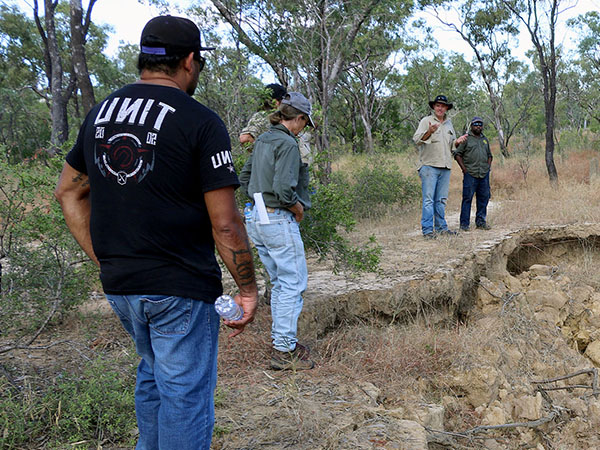
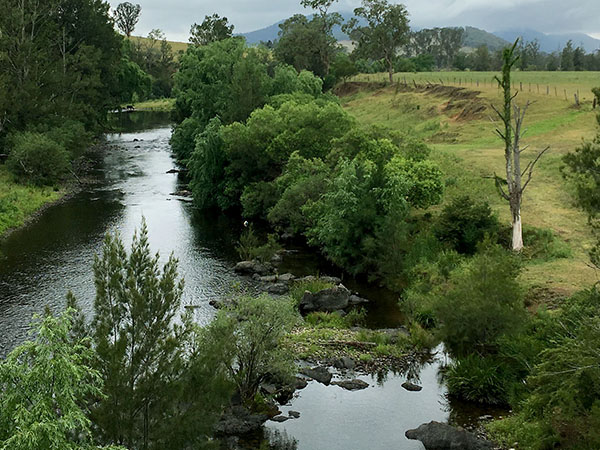
Riparian vegetation assessment and prioritisation
This project is developing a refined approach to delineating riparian areas and quantifying the extent of riparian vegetation as the basis for a catchment-wide riparian management strategy. With LiDAR data now available across the whole of NSW, the project offers a major opportunity to develop tools that will significantly improve our ability to manage river catchments. In this project we are refining methods developed in the Hunter catchment to quantify and prioritise those areas of the stream network that need management intervention to improve riparian vegetation structure and composition. We have developed procedures for automating the delineation of the riparian zone and the characterisation of vegetation from catchment-wide LiDAR data sets.
Funding sources: NSW Government: Local Land Services Hunter Region
Technical advice to Reef Trust investment program
The Australian Government’s Reef Trust investment program is a major vehicle for investment in reef water quality programs in the Great Barrier Reef catchments. In this project we provide technical advice to the partners delivering projects on the ground and help administer the program with the Australian Government.
Funding sources: Department of Environment/CSIRO
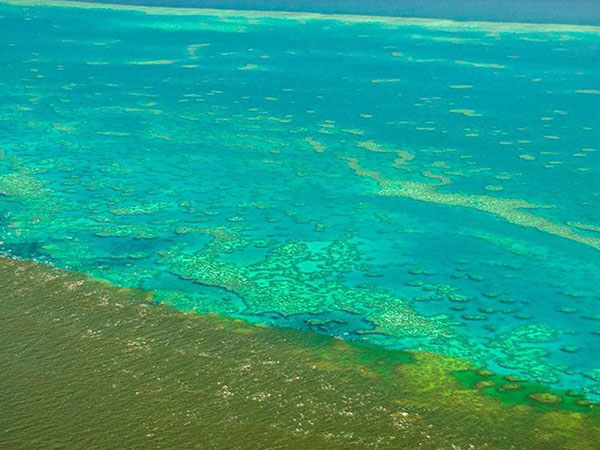
Partnerships
Our group has extensive partnerships with the Queensland Government’s Department of Environment and Science, through the Office for Great Barrier Reef and the Landscape Sciences, and Science and Technology Division. In addition to active collaborations in five featured projects, Associate Professor Brooks sits on the GBR Sediment Working Group, a joint Federal and Queensland Government initiative facilitated through the Office for Great Barrier Reef.
The Australian Government’s Reef Trust investment program is a major vehicle for investment in reef water quality programs in the Great Barrier Reef catchments. We provide technical advice to partners delivering projects on the ground and help administer the program with the Australian Government.
We also undertake numerous projects funded through NESP (and its predecessors) that address high-priority research needs of the Federal Government and whose outcomes feed directly into government policy.
Natural Resources Management Agencies represent the frontline for implementation of projects funded by government to achieve on-ground environmental outcomes. Applied research in catchment and water quality management can only work in a collaborative environment characterised by a two-way flow of information and ideas between scientists and land managers.
Often the end-users are land holders themselves, and it is these groups that provide the interface and point of first contact with landholders. For this reason, we work closely with a range of these groups, including:
- Cape York NRM
- NQ DryTropics
- Reef Catchments
- Terrain
The gully rehabilitation research projects we are undertaking on Strathalbyn Station in the Burdekin is a continuing partnership with NESP, Greening Australia Fruition Environmental, the Queensland Government and the Great Barrier Reef Foundation. To date, this is the largest gully rehabilitation project undertaken in the Great Barrier Reef and has generated a large volume of research on this strategy as a means of reducing sediment input to the reef.
We are currently part of a consortium with these companies to implement Reef Credits projects using gully erosion methodology we developed and the second officially endorsed methodology under the Reef Credits scheme.
Contact details
- Phone
- (07) 5552 7269
- Location and postal address
- Coastal and Marine Research Centre
- Room 2.01, Building G51
- Griffith University
- Gold Coast, Queensland, 4222